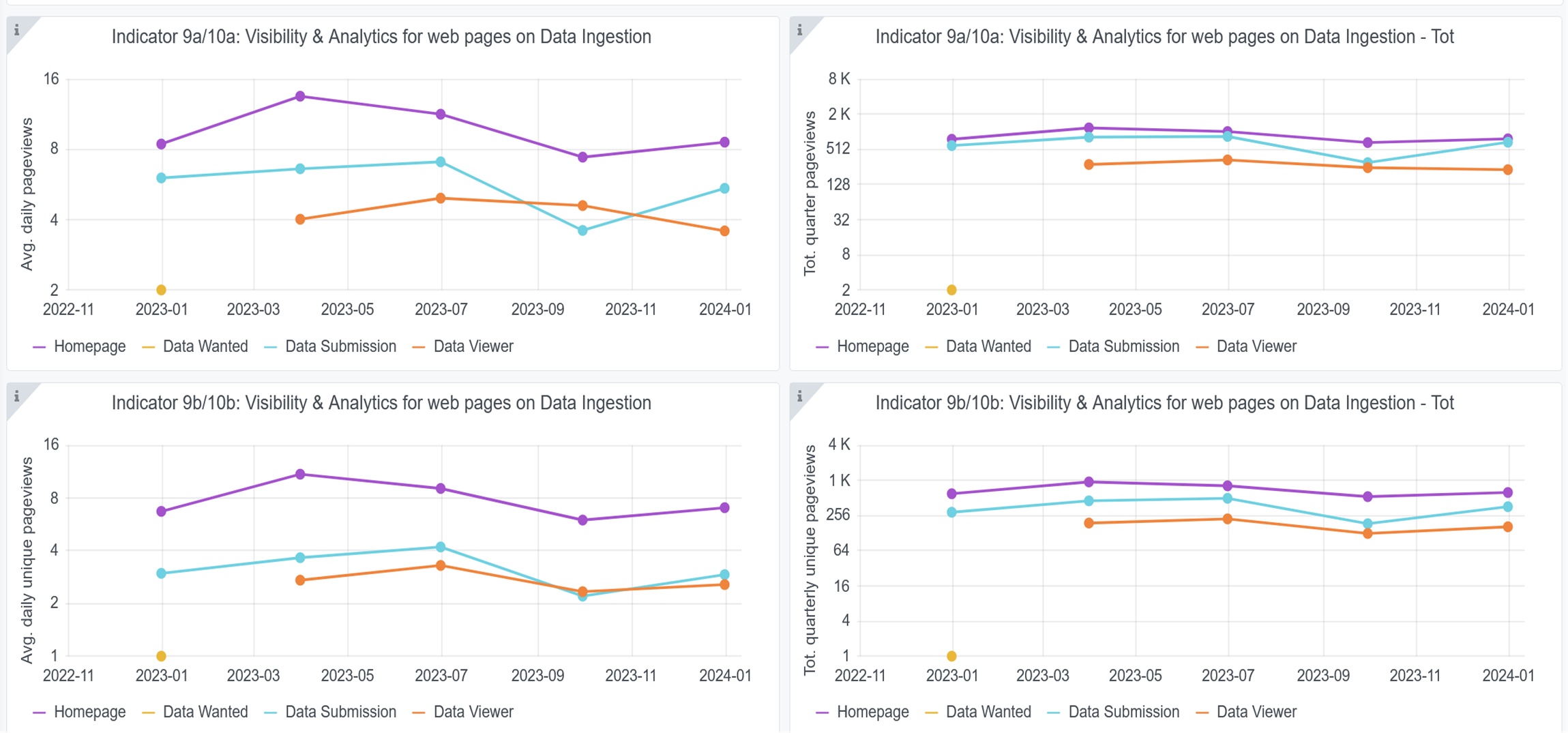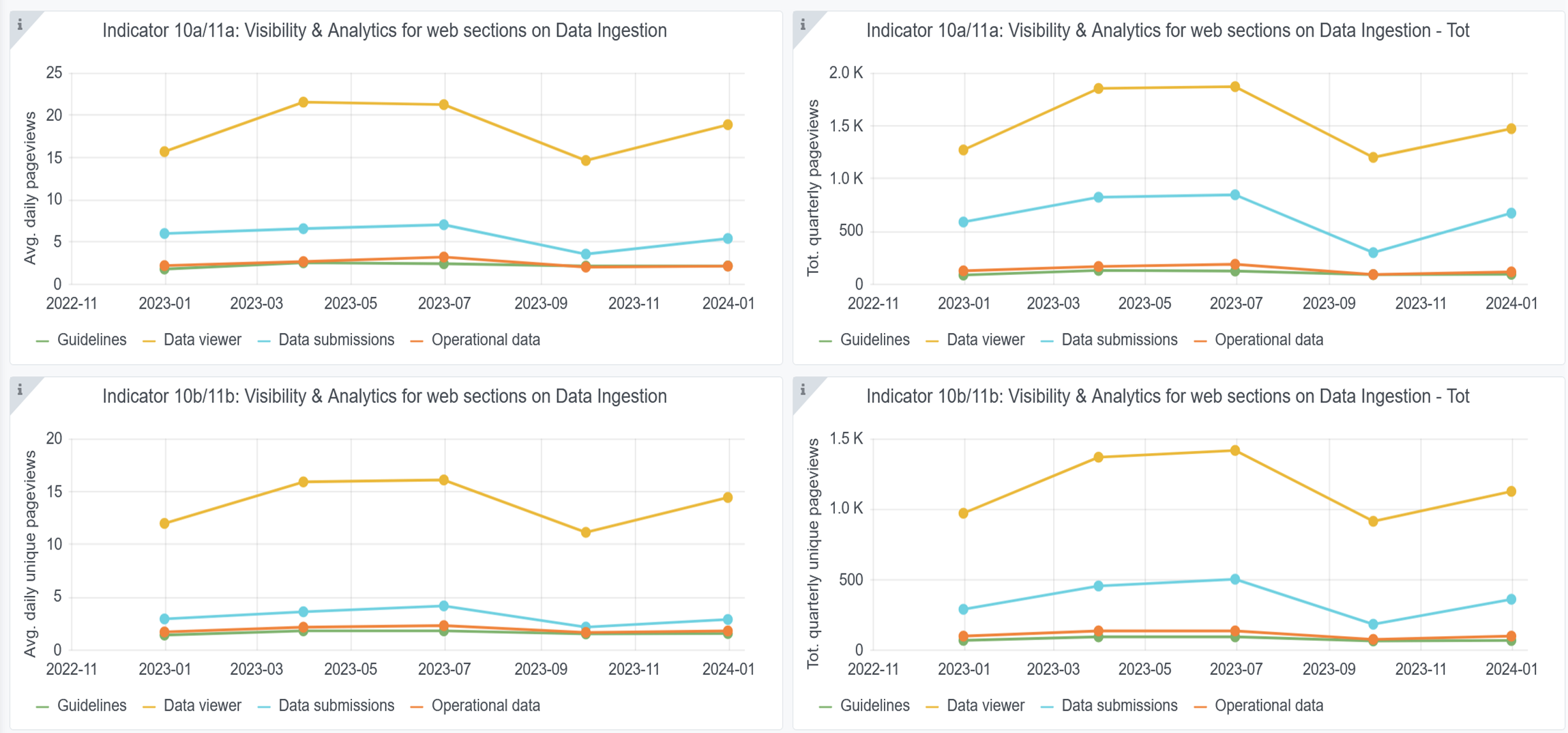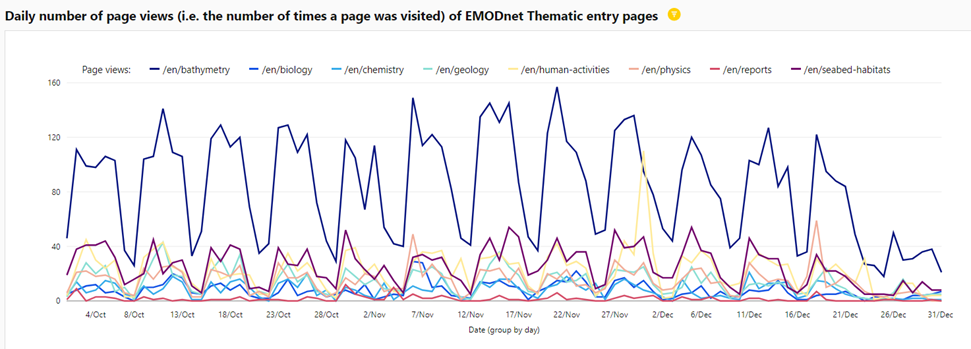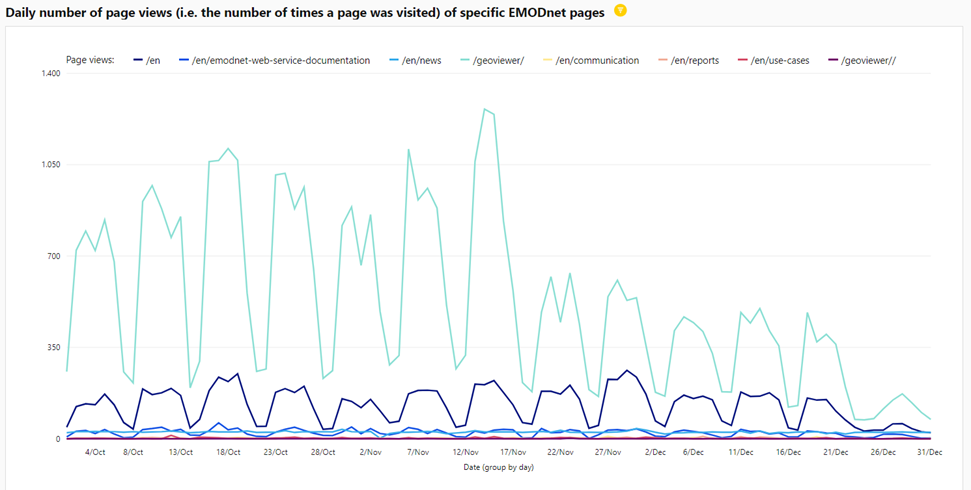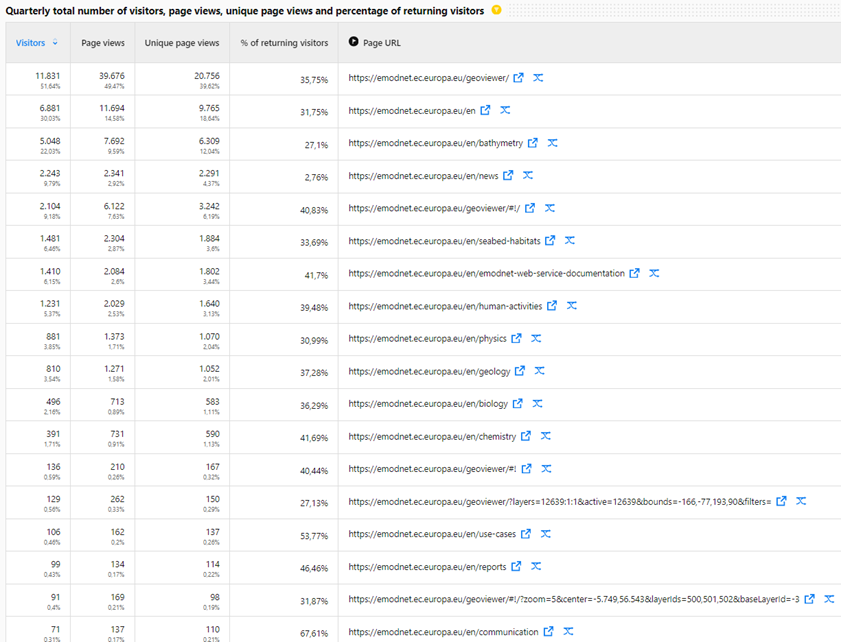EMODnet progress overview
General progress highlights
On 27-30 November 2023 over 340 partners, associated partners, and stakeholders of the European Marine Observation and Data Network (EMODnet) gathered in Brussels for the third EMODnet Open Conference and Jamboree. The week kicked off with a Partner Jamboree with the >120 partners exchanging on their latest service developments and joint activities. The Open Conference was a public event, moderated by Karen Coleman. With a line-up of over 75 speakers across the 1.5 days, the event highlighted EMODnet’s crucial role in the European Marine Data Ecosystem, focusing on a "Digital and Green Future". If you missed a session or want to revisit the insights, the EMODnet Open Conference 2023 website includes all Plenary video recordings, Plenary and Townhall presentations. Read the news article on the Open Conference and Jamboree. A conference report will be published soon, stay tuned by subscribing to our monthly newsletter.
In the Conference Closing Session on 30th November 2023, Kate Larkin (Head of EMODnet Secretariat) presented an EMODnet Call to Action on behalf of the EMODnet Partnership. The Call to Action identifies a number of key areas where EMODnet will continue to evolve through well-identified opportunities on the way to 2035. It also recognises that to continue delivering on the existing services, whilst also expanding services to address the needs of the Green and Digital Transitions, EMODnet requires community and political action to ensure sustainability and resources appropriate for a fully functioning, operational service of the European Commission. It then calls on key actors in the marine and maritime community in Europe and beyond to work with EMODnet to further shape its evolution and impact.
At the start of the EMODnet Open Conference 2023 the two EC marine data services EMODnet and Copernicus Marine Service, launched a joint communication on the EU in situ marine data landscape. The statement explains the complementarity between the two EU marine knowledge assets, and also how the services work together, following a high-level agreement between DG DEFIS and DG MARE and the signature of Memorandum of Understanding (MoU) in 2016.
Specific progress and achievements of the thematic data assembly groups and data ingestion
- There was an increase in the number of Common Data Index (CDI) entries from 42,153 to 42,369 for EMODnet Bathymetry. Similarly, the number of Composite Digital Terrain Model (DTM) entries increased from 277 to 279. In the coming months, the data gathering activities will be completed, and pre-processing of the data to 1/32*1/32 gridded datasets will take place, for transfer to the Regional Coordinators for the generation of the Regional DTMs. During the EMODnet Jamboree (27-28 November 2023), the EMODnet Bathymetry consortium had a dialogue with GEBCO and Seabed 2030 about cooperation and synergies, and how to arrange that data from European data providers will go through EMODnet to GEBCO and Seabed 2030;
- The new data harvest brought 12 new datasets into EMODnet Biology, increasing the occurrence data holding by approximately 1.5 million new records. EMODnet Biology organised a training workshop on how to use citizen science platforms like Zooniverse to capture data that exist only in paper format. Discussions with the EC Joint Research Centre (JRC) and DG Environment are ongoing to strive for a better involvement between EMODnet Biology and the EU’s official monitoring data mechanisms, which could result in data (re)publication via EMODnet Biology. In addition, EMODnet Biology is actively involved in several EU funded research projects to ensure that data flows are established, clarified or maintained and provide technical support;
- EMODnet Chemistry maintains constant dialogue with projects such as NAUTILUS and REMEDIES that are willing to share their collected data. The new version of the regional aggregated, validated and harmonised data collections for eutrophication and pollutants were published in the EMODnet Portal. Furthermore, 43 new data layers were published in the EMODnet Map Viewer. As of this quarter, all EMODnet Chemistry data products are hosted by ULiège, HCMR Geoserver and Ifremer Geoserver;
- The migration of the EMODnet Data Ingestion Portal to the EMODnet Central Portal is in progress and is estimated to be completed by the end of Spring 2024. With regard to the Submission service, it was discussed with the Central Portal Technical Team that the front end will be split from the back end, and both will be connected by an Application Programming Interface (API). The content of the Viewing service will be integrated into the EMODnet central products catalogue, and the real-time viewer service will continue to be hosted by EMODnet Physics coordinator and ingestion partner ETT. The viewer will interact with the EMODnet central map viewer. Up to 39 dataset submissions were received in the reporting period, bringing the total number of received submissions to 1,549. The number of processed and published data submissions increased from 1,367 to 1,411, of which the number of fully elaborated data submissions went from 624 to 639. Several additional operational stations, e.g. river stations, gliders, surface unmanned vehicles, were integrated into the system meaning that machine-to-machine connections are being set up between the provider and EMODnet so that new data are available as soon as the providers start collecting/transferring data;
- Several EMODnet Geology partners participated in the Horizon 2.5 Climate, Energy and Mobility project ‘Geological Service for Europe’ (GSEU), thereby enabling synergy and direct feedback between GSEU and EMODnet. For example, Geological Survey of Ireland (GSI) leads a WP within the GSEU project with the objective to coordinate data into the EMODnet portal. Additionally, EMODnet Geology coordinator is in the advisory board of two Horizon Europe projects (TRIDENT and S34I) and is thus acting as a link between these projects and EMODnet. The Caribbean Sea subtask has set up a Caribbean working group to address the collaboration in the different EMODnet Geology work packages. The Caspian Sea subtask is working on upgrading the different elements for each EMODnet Geology work package with the aim to include higher resolution data products by the end of the phase (i.e. end September 2025);
- During the EMODnet Human Activities partner meetings during the third EMODnet Open Conference and Jamboree in November 2023, it was discussed with the International Council for the Exploration of the Sea (ICES) that closer dialogue and cooperation should be pursued with the goal of making available more fisheries-related data. A new version of the method for making vessel density maps was published on the EU Publication Office and was also uploaded to the EMODnet Portal. Compared with the previous version, this version recommends using a different software stack to speed up calculations. The method now has a DOI. In December 2023, a meeting took place with the Black Sea Commission (BSC), where it was discussed that EMODnet Human Activities could be admitted as an observer during BSC meetings. Furthermore, the BSC offered to put EMODnet Human Activities in contact with some of their data sources, e.g. Shipping Activity Centre in Bulgaria, and Odessa pollution and biological database;
- EMODnet Physics updated a number of products, such as the Coriolis Ocean datasets for reanalysis; temperature and salinity along trajectories, etc. There is an ongoing action with new data providers from New Zealand and Australia. As such, as first data package from fishing vessels to the Moana project have already been integrated “as is”;
- All EMODnet Seabed Habitat consortium partners have begun work to gather and format the data described in the project proposal. Partner ISPRA have designed a new data collation tracker, which allows tracking the status of data acquisition, preparation and upload. To make the EMODnet Seabed Habitats products fully compliant with the EurOBIS environment so that all unrestricted habitats point data can be directly uploaded into this repository, point data, map and essential fish habitat templates (tables and shapefiles) were updated.
EMODnet portal usage
User visit statistics
Since centralisation and thus as of 25 January 2023 onwards, statistics on user visits to the EMODnet Central Portal are collected through Europa Analytics. Below we provide the quarterly total (for the period October-December 2023) or daily number of page views[1] (in absolute number) of the EMODnet Portal Homepage, a selection of webpages, and each of the thematic entry pages.
- Compared to the previous quarter, an increase of 19% was recorded in the number of page views of the EMODnet portal homepage (from 9,511 to 11,694 page views), which is comparable to the numbers from Q2 2023 before the summer holidays;
- In the reporting period, the geoviewer (i.e. central map viewer) received over 45,000 page views;
- The page containing web services documentation received a total of 2,084 page views;
- The web pages geoviewer, use cases, reports and communication continued to have a high percentage of returning visitors (between 35 and 68%);
- Of all the thematic entry pages, EMODnet Bathymetry remained the most visited one in the past quarter. The second most viewed entry page was again the one of Seabed Habitats, followed by Human Activities, Physics, Geology, Biology and Chemistry (with no change in order compared to the previous quarter);
- Specific numbers for the thematics are:
- An increase of 153% was recorded in the number of page views for the Bathymetry entry page (from 6,533 to 7,692);
- The number of page views for the Biology entry page increased by 22% (from 557 to 713);
- An increase of 31% was recorded in the number of page views for the Chemistry entry page (from 559 to 731);
- The number of page views for the Geology entry page increased by 5% (1,208 to 1,217);
- The number of page views for the Human Activities entry paged increased by 23% (from 1,652 to 2,029);
- The number of page views for the Physics entry page increased by 2% (from 1,348 to 1,373);
- The number of page views for the Seabed Habitats entry page increased by 12% (from 2,029 to 2,304).
The Data Ingestion Portal is not yet centralised, hence web traffic to their portal is currently still being tracked using Matomo. Average daily page views for the various web pages range between 4 and 16.
Statistics on usage of EMODnet thematics and data ingestion[2]
Since the second quarter of 2023 onwards, there has been a change from reporting on download metrics by the individual thematic portals to metrics being centrally reported from the new unified portal. This affects the thematics in different ways, depending on their technical back-end infrastructure. The new unified metrics are still being developed and will be fully deployed over the next few quarters. Some caution is advised with regards to the metrics at this stage.
Number of data downloads[3]
- There was an increase in number of downloaded CDIs from EMODnet Bathymetry compared to previous quarter, i.e. from 4 to 468 CDI downloads;
- EMODnet Chemistry CDI downloads decreased from 11,879 to 9,252;
- EMODnet Data Ingestion recorded an increase of 86% in number of data download transactions, from nearly 246 to 458;
- A 30% increase in EMODnet Human Activities dataset download was recorded (from 1,972 total downloads to 2,574), which is consistent with historical trends as Q4 comes after the Summer season where usage tends to decrease. Among the most downloaded datasets were the Wind Farms (284 dataset downloads), Maritime Spatial Planning (128) and Telecommunication Cables (127);
- For this quarter, EMODnet Seabed Habitats observed an increase in the number of manually downloaded records from the dataset Collection of Classified Points from 28,580,522 to 35,236,260.
Number of data product downloads[4]
- An increase was recorded in the number of downloads of EMODnet Bathymetry DTM tiles (from 7,104 to 17,744 downloads) and in number of downloaded High-Resolution DTMs (from 1,279 to 10,770 downloads);
- A decrease was recorded in the number of data product downloads for most of the EMODnet Geology data products. The higher download numbers in the previous period were likely the result of the end of the previous contract/phase. The most downloaded data product was the Seabed Substrate (592 downloads), followed by Sea-floor Geology (153) and Events and Probabilities (70);
- For EMODnet Human Activities, 912 Vessel Density Maps datasets were downloaded this quarter, representing an increase of 5% since the previous quarter. Similarly, the Route Density Maps were downloaded 712 times, representing an increase by 27%;
- An increase in the number of product download transactions through ERDDAP (from 268,966 to 2,220,808) was observed for EMODnet Physics;
- For the most part, increases were observed in the number of downloaded datasets for EMODnet Seabed Habitats, with the exception of a few decreases. The most downloaded product dataset remained the Habitats - seabed habitats (including coastal wetlands) - collection of classified maps (from 86,274 to 84,996 dataset downloads). The flagship product EUSeaMap (seabed habitats (including coastal wetlands) broad-scale mapping) was downloaded 2,728 times. Essential fish habitats collection of models was downloaded zero times
Upcoming EMODnet meetings and events
The main EMODnet event planned for the coming quarterly period in 2024 is:
- EMODnet Webinar: EMODnet for Horizon Europe and EU Mission: Restore Our Ocean and Waters projects, taking place as an online webinar on 28 February 2024, 11am-12:30pm CET. This is invitation-only with a view to providing information and guidance to projects that produce in situ marine data and yet do not have an established pipeline for data ingestion into EMODnet.
More information
More information about EMODnet’s resources is available at the following links:
- EMODnet Data and Data product portfolio: https://emodnet.ec.europa.eu/en/data-portfolio
- EMODnet for Business brochure: https://emodnet.ec.europa.eu/en/emodnet-business-brochure
- Thematic assembly groups
- EMODnet Bathymetry - https://emodnet.ec.europa.eu/en/bathymetry
- EMODnet Biology - https://emodnet.ec.europa.eu/en/biology
- EMODnet Chemistry - https://emodnet.ec.europa.eu/en/chemistry
- EMODnet Geology - https://emodnet.ec.europa.eu/en/geology
- EMODnet Human Activities - https://emodnet.ec.europa.eu/en/human-activities
- EMODnet Physics - https://emodnet.ec.europa.eu/en/physics
- EMODnet Seabed habitats - https://emodnet.ec.europa.eu/en/seabed-habitats
- Data Ingestion Service
- EMODnet Data Ingestion - www.emodnet-ingestion.eu
- Sea-basin Checkpoints resources
For an overview of and access to information and outputs from each of the Sea-basin Checkpoints (projects ended), visit: https://emodnet.ec.europa.eu/en/checkpoints
- North Sea checkpoint - https://emodnet.ec.europa.eu/en/checkpoint/north-sea
- Mediterranean checkpoint - https://emodnet.ec.europa.eu/en/checkpoint/medsea
- Artic checkpoint - https://emodnet.ec.europa.eu/en/checkpoint/arctic
- Atlantic checkpoint - https://emodnet.ec.europa.eu/en/checkpoint/atlantic
- Baltic checkpoint - https://emodnet.ec.europa.eu/en/checkpoint/baltic
- Black Sea checkpoint - https://emodnet.ec.europa.eu/en/checkpoint/black-sea
[1] The number of times a page was visited.
[2] For thematics which provided this information.
[3] Disclaimer: please note that percentages given can reflect small as well as large changes in the number of data and data product downloads. In most cases however it is difficult to provide an actual explanation for the downloading behaviour of users.
[4] Disclaimer: please note that percentages given can reflect small as well as large changes in the number of data and data product downloads. In most cases however it is difficult to provide an actual explanation for the downloading behaviour of users.
